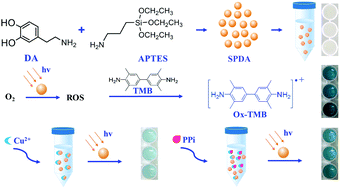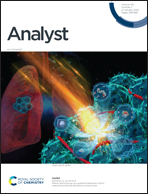Silica-polydopamine hybrids as light-induced oxidase mimics for colorimetric detection of pyrophosphate†
Abstract
In this study, silica-polydopamine hybrids (SPDA) were fabricated by a facile and one-step heating method using dopamine and (3-aminopropyl)triethoxysilane (APTES) as the reaction reagents. It was firstly found that light illuminated-SPDA could oxidize colorless 3,3′,5,5′-tetramethylbenzidine (TMB) to produce blue ox-TMB. The coloration process was quenched very efficiently via the addition of Cu2+. The presence of pyrophosphate ion (PPi) in the solution of light-illuminated SPDA-Cu2+-TMB induced the recovery of the coloration process. The recovery occurred because PPi coordinated with Cu2+, effectively sequestering the ion from SPDA. A calibration curve was developed that is related to the extent of absorption recovery to [PPi], making the SPDA-Cu2+-TMB system a sensitive and selective turn-on sensor for PPi detection. The limit-of-detection (LOD) for PPi was 0.06 μmol L−1 (S/N = 3) with a linear dynamic range of 0.1–30 μmol L−1 and the calibration curve of linear equation is given as: y = 0.00146x + 0.05096 (r = 0.9974). The proposed method has been successfully applied to the detection of PPi in human serum with satisfactory recovery. The simplicity, low cost, high sensitivity, good reproducibility and excellent selectivity of the PPi detection platform based on the light-induced oxidase mimicking property of SPDA makes it promising for further applications of SPDA in chemo/biosensing.



 Please wait while we load your content...
Please wait while we load your content...